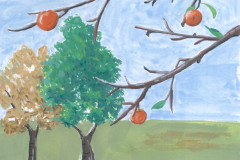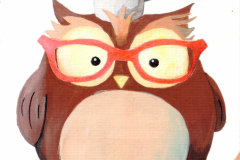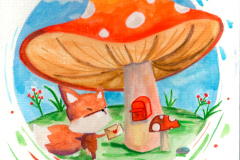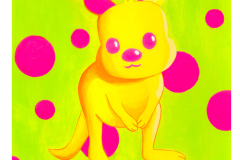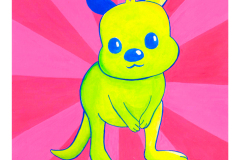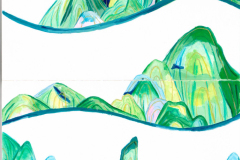Introduction
Van Gogh is one of the most famous painters history has known. He created bold, colorful works that captured emotions and scenes with thick brush strokes. His style influenced art around the world. Studying Van Gogh can help you learn unique painting techniques and express yourself creatively using gouache paint. Gouache is a type of paint known for bright colors and easy coverage. It lets you build layers and textures, like Van Gogh’s artwork. If you want to try a new painting method, applying Van Gogh’s ideas to modern gouache might be your next step.
This article looks at how to use Van Gogh’s style in your gouache paintings. You will get tips on basic gouache techniques inspired by his work. Also, you will learn how to mix colors and use brush strokes to make your art lively and full of emotion. The step-by-step chapters will guide you from basics to more advanced effects. By the end, you can create pictures with the feel of Van Gogh’s paintings while using modern gouache methods. Are you ready to start painting like one of the great artists?
Understanding Van Goghs Painting Style
Vincent van Gogh painted with passion and intensity. His style stands out because of three key features: bold color, energetic brushwork, and raw emotion. He chose colors that spoke louder than words, making his scenes vivid and alive. His brush strokes moved with purpose—they were thick, swirling, and full of texture. These strokes gave shape and depth beyond simple outlines. Most of all, his paintings express feelings openly. Van Gogh did not aim for perfection; he wanted to make you feel something through his art.
Why does his style still inspire painters today? It breaks rules while staying deeply personal. You don’t need to replicate every detail, but you can learn from how he painted with courage and feeling.
Color Choices and Emotional Impact
Van Gogh used strong colors to show moods directly. Bright yellows brought energy in “Sunflowers.” Deep blues in “Starry Night” evoke calm and mystery. His colors often clash or shine side-by-side, creating tension that pulls your eye. Contrast and harmony worked hand in hand to boost his message. He understood how a color can change your emotional reaction. When you paint, try pushing your own color limits. Can you make a green that feels wild or a red that hurts?
Brushwork Techniques
His brush strokes tell stories within his paintings. Thick, visible strokes appear everywhere. You can almost see the motion of his hand. Swirling lines in the sky or sharp dashes for tree branches give movement. This texture adds life beyond flat shapes. Van Gogh layered paint so you can feel the surface with your eyes. When using gouache, try applying paint thickly. Allow your brush strokes to remain bold and free. How can the energy in each stroke express the subject’s spirit?
Introduction to Gouache Paint and Its Features
What Is Gouache Paint
Gouache is a water-based paint made from pigment mixed with a binding agent, usually gum arabic. It stands out because of its strong opacity and bright colors. Unlike watercolor, which often looks transparent on paper, gouache covers surfaces fully, allowing you to paint light colors over dark ones. When dry, gouache creates a matte finish that stays vibrant without shine. You can re-wet and adjust your work even after it has dried, making it flexible during painting sessions. This quality lets you celebrate bold shapes and sharp details, a style similar to what Van Gogh pursued with his vivid color patches and lines.
Advantages of Gouache for Beginners
Gouache is friendly for beginners because it dries quickly, so you can work faster and see results without long waits. Mistakes don’t have to stay; you can paint over areas once dried, making corrections simple. The paint’s thick consistency gives you control while layering colors to build form and depth. Bright pigments keep colors lively, encouraging you to experiment boldly without worry. If you wonder how Van Gogh achieved intensity and texture, gouache offers a modern way to practice these effects without the complexity of oil paints or the transparency of watercolors.
Basic Gouache Techniques for Van Gogh Style Painting
Van Gogh’s paintings often show thick, textured layers of color. To capture this with gouache, start by applying paint in multiple layers. You can begin with a light base and let it dry before adding more saturated tones. This builds richness and depth in your work. Think about how each layer affects the next one, allowing the paint underneath to influence the final color.
Blending in gouache is different from watercolor or oils. You want to keep some edges sharp and some soft. Use a damp brush to soften colors at the edges while leaving brush marks elsewhere. This helps create movement and energy, much like Van Gogh’s style. Try working quickly so the paint stays wet enough to blend but thick enough to keep texture.
Handling your brush plays a major role in creating Van Gogh-like effects. Use firm, deliberate strokes and vary your pressure. Thicker strokes create bold texture, while lighter touches add detail. Use different brush sizes to layer texture, from broad strokes to fine lines. This approach will help your painting look alive and vibrant.
Layering Colors for Depth
Layering colors is key to reaching the depth Van Gogh achieved. Start with a mid-tone background and let it dry completely. Apply more intense colors on top, using semi-opaque or thick paint for stronger highlights. Each layer should add value and color shifts, not just cover what’s beneath.
Look closely at Van Gogh’s work. He often used colors that contrast but complement each other. When you layer, think about how your colors talk to one another. Try layering warm yellows over cool blues to create a rich, dynamic surface. Wait between layers to avoid muddying colors. This helps you control the vibrancy and texture.
Using Brush Strokes to Add Texture
Van Gogh’s brushwork stands out because you can see each individual stroke. You can imitate this by using different brush sizes and pressures. For thick texture, press down with a large flat brush and drag. For finer details, use a small round brush and lift lightly to create thin lines.
Mix long and short strokes to create variety. Don’t try to hide your brush marks. Instead, let the paint show the direction and emotion of your strokes. Vary the speed of your brush movement. Quick, decisive strokes will produce rough texture. Slower strokes can smooth areas, giving your painting contrast and energy.
Ask yourself: How can my brushwork add emotion or movement? Practice controlling your strokes until you feel comfortable layering texture and color like Van Gogh did.
Mixing Colors to Capture Van Goghs Palette
Van Gogh’s palettes show strong yellows, blues, greens, and earth tones that bring energy and natural feeling to his paintings. To copy his look, start by mixing your gouache colors carefully. Avoid using pure tubes directly from the palette. Instead, experiment with combining colors to mimic the rich yet raw tones Van Gogh favored.
For example, mix cadmium yellow with a touch of lemon yellow to create vibrant yellows. Add a hint of orange or burnt sienna when you want a warmer, aged yellow shade. For blues, blend ultramarine blue with cobalt blue to capture the depth found in his night skies and fields. Tone it down slightly by mixing with white for softer skies.
Creating balanced natural colors involves mixing browns and greens carefully. Combine burnt sienna or raw umber with greens made by blending cobalt blue and lemon yellow to represent grass, foliage, or rustic backgrounds. Adjust each mix by adding small amounts of white or black to control brightness and shadow.
Ask yourself: which shades best pull the feeling from Van Gogh’s breath-taking scenes? Practice mixing to suit your painting’s mood while staying true to his authentic style. This hands-on mixing builds your control over gouache and helps you produce colors that resonate with his style.
Creating Vibrant Yellows and Blues
Start with cadmium and lemon yellow to achieve bright yellows like Van Gogh’s sunflowers. Add small dabs of orange or burnt sienna for warmth. Keep your strokes visible to show vibrancy rather than blending colors too smoothly.
For deep blues, combine ultramarine with cobalt blue. Ultramarine gives night depth, cobalt adds brightness. If the blue feels too dark, add a little white to lighten while keeping the saturation.
Test your mixes frequently on a palette paper to see how they dry. Gouache dries a bit duller, so mix colors slightly brighter than you want. Layer your colors for texture like Van Gogh’s, using broken brush strokes with visible color shifts.
Try making small batches and adjust your mixes based on what you see. This practice helps you control the punchy yellows and moody blues Van Gogh used to give his paintings energy.
Balancing Earthy and Natural Hues
Van Gogh often used earth tones as backgrounds or subtle color accents. Mixing burnt sienna with raw umber forms the base for rich browns. Lighten these using white or add tiny touches of blue to cool down the tone.
To create greens reflecting nature, blend cobalt blue with lemon yellow carefully. Adjust green’s warmth or coolness by adding red or blue respectively. Adding burnt sienna or raw umber softens greens to match natural foliage instead of bright artificial colors.
Use these earth tones to build a natural, grounded feel in your compositions. Test how these colors interact when layered under yellows or blues to maintain harmony in your painting.
Consider how natural hues support brighter areas or help objects recede. How strong should your earthy colors be? Keep practicing mixing small amounts to build subtle, balanced results that echo Van Gogh’s strong yet naturalist style.
Planning Your Van Gogh Inspired Painting
Before you start applying paint, take time to plan your gouache painting carefully. Think about what story or feeling you want to tell. Van Gogh’s works often reveal strong emotions through vivid scenes and bold designs, so consider how you can express that in your composition.
Begin by deciding what main shapes and elements will appear in your painting. Are you painting a swirling night sky, a quiet village, or a lively field? Knowing this helps you arrange your composition to catch the viewer’s eye.
Next, choose a color theme that supports the mood you want. Van Gogh frequently used contrasts of yellow and blue or greens mixed with earthy tones. These choices influence how your painting feels, whether calm, energetic, or intense.
Ask yourself: What emotion do I want to share through my painting? How will using space and color help me achieve that? Planning this way gives your work focus and direction before you pick up your brush.
Sketching the Composition
Start your Van Gogh-inspired gouache painting with a light pencil sketch. Use simple lines to mark the main shapes and positions of objects. Don’t worry about details yet; focus on getting the big picture right.
Use broad, confident strokes for the outline rather than tight, exact marks. Van Gogh’s style thrives on energy, so keeping your sketch loose helps maintain that liveliness. Plan where your swirling shapes or thick lines will go.
Think about balance in your composition. Are the shapes spread evenly? Do they guide the viewer’s eyes naturally around the canvas? Experiment with moving elements in your sketch until the layout feels right.
Remember, this sketch is your map. It prevents mistakes and saves time when you start applying gouache. Preparing this stage well ensures your painting will stay organized and focused.
Choosing a Mood with Colors
Colors carry strong emotions, so pick a palette that fits the mood you want in your painting. Van Gogh used colors not just realistically, but to show feelings. Think about how color choices influence your viewer’s reaction.
If you want calmness, try cool blues and soft greens. Feelings of energy or passion come alive with warm yellows, oranges, and deep reds. You can even combine these to create tension or excitement.
Use the palette you mixed earlier but think beyond accuracy. Which colors speak to your chosen mood? Test combinations on a small sheet to see how they interact. Sometimes a small change in color can shift the whole feeling of your work.
Ask yourself: What do I want viewers to feel? How can these colors help me express that? Choosing colors with purpose boosts the emotional power of your painting and honors Van Gogh’s style.
Applying Van Gogh Inspired Brush Strokes
Van Gogh’s painting style is full of energy and movement expressed through his brush strokes. To achieve a similar effect with gouache, focus on making your strokes short and lively. Avoid smooth blending for now; instead, let each stroke stand out and catch the viewer’s eye.
You can start by loading your brush with a moderate amount of paint—not too thin or too thick. Use a flat or filbert brush to maintain control while creating strokes that follow the shapes in your composition. Think of each stroke as a small, deliberate action that builds rhythm across your canvas.
Van Gogh often layered his strokes, placing new colors on top of dried paint. This technique adds texture and depth. Try layering contrasting colors with short strokes in different directions. This method will bring your gouache piece to life and help you capture the sense of motion Van Gogh achieved.
Short Thick Strokes
Short, thick strokes carry the energy you want to replicate from Van Gogh’s work. When you apply gouache, squeeze enough paint on your brush to form dense patterns on your paper. Press the brush lightly but firmly, creating visible marks.
Practice painting small patches like leaves or petals using only short strokes. These strokes should not be smooth lines but rather small dashes of paint that build up form. It might help to think about how a duster flicks dust in quick bursts—each mark matters.
Keep your hand moving quickly, and don’t blend the strokes too much. This technique helps separate colors on the canvas and increases vibrancy. How can you control the pressure and speed to make these strokes unique to your style?
Building Texture with Layers
Layering is key for creating texture and momentum in your gouache paintings. Wait until the first layer dries before adding the next. Apply your strokes in different directions to avoid flattening the image. This gives the painting surface more complexity.
Try alternating colors or tones in your layers. For example, a base of blue strokes can receive shorter yellow or white strokes on top to simulate light and movement. Each layer should enhance the depth, not cover the previous completely.
Think about how the textures interact. Does one layer feel rough or smooth? Can the colors beneath still be seen? Using layering thoughtfully will help your work resemble Van Gogh’s vibrant, tactile paintings. What new effects can you create by mixing colors in your layers?
Adding Details and Highlights
Adding details and highlights brings your gouache painting to life. Van Gogh’s works often show strong contrasts and bright lighting that make objects pop. You can achieve this by focusing on where the light hits and carefully building up highlights with lighter paint.
Start by identifying the light source in your painting. Think about where the light naturally falls and which areas need emphasis. Use gouache to apply thin layers of light colors to those spots. This method creates depth and makes details stand out without overwhelming your artwork.
Van Gogh’s paintings show that highlights don’t have to cover large areas. Small touches of white, yellow, or pale blues add interest and draw the eye. These accents sharpen forms and bring energy to your piece.
Study Van Gogh’s contrasts. Notice how sharp highlights allow shadows and darker colors to gain more intensity. This balance between light and dark helps your painting feel vibrant and dynamic.
Using Light Colors for Highlights
You can use light colors in gouache to emphasize certain parts of your painting. Choose paints like white, cream, or soft pastel tones that suit your palette. Apply these colors over dry layers for clear highlights.
Use a small, firm brush for control. Dab or gently stroke the paint where light should sparkle, such as the edges of leaves, petals, or where sunlight hits a building.
Try mixing your light colors with a bit of water for a thinner, translucent effect. This helps blend highlights smoothly into surrounding colors and avoids harsh lines.
Consider Van Gogh’s swirling skies or glowing sunflowers. Notice how he uses light paint almost like a spotlight to bring focus. Ask yourself where you want viewers’ eyes to rest, then add light touches there.
Incorporating Small Details
Small details give your painting texture and interest. Van Gogh’s paintings often include fine elements like thick flower petals or tiny bright stars. Using a fine brush, you can replicate this sense of detail in gouache.
Pick a brush with a pointed tip, such as a size 0 or 1 round. Thin your paint slightly to improve flow but keep it thick enough to stand out.
Add details slowly and patiently. Focus on the shape of a single petal or the dot of a star. Work in layers, letting paint dry between additions to maintain precision.
Look closely at your subject. What small marks or shapes can you create? Adding these inspires a natural look and challenges you to practice steady, careful brushwork.
By building up tiny details, you’ll find your painting gains more personality and depth, much like Van Gogh’s vibrant works.
Common Mistakes and How to Fix Them
Many beginners struggle when trying to paint gouache in Van Gogh’s style. One typical mistake is overblending colors. You might think mixing colors smoothly is good, but too much blending washes out the vibrant energy Van Gogh’s paintings have. The distinct brush strokes are part of what makes his style unique. To avoid this, use short, confident strokes and let the paint texture show through. Practice layering colors side-by-side rather than mixing them fully on the palette. This way, your colors stay bright and alive while keeping that texture visible.
Another common pitfall is painting with paint that is either too thick or too thin. Thick paint can clog your brush and cover previous layers, while paint that’s too thin will lose its opacity and important texture. You want to find a balance that lets you build layers and create texture without losing control. Try diluting your gouache with just enough water to make it flow, but not drip. Test on scrap paper before applying to your painting. This control helps you mimic Van Gogh’s natural layering and impasto effects, giving your work dimension and depth.
Overblending Colors
Overblending reduces the boldness that gouache offers. Van Gogh’s style shows brush marks, vibrant edges, and intense color contrasts. When you blend too much, those qualities fade. Instead of mixing colors into each other completely, try applying paint next to different colors and gently stroke over the edges. This technique keeps each color’s brightness intact. Do you find yourself constantly mixing colors on the palette? Try working directly on the paper with separate colors to keep your strokes distinct and textured.
Painting Too Thickly or Thinly
Painting with gouache requires a feel for how thick the paint should be. Paint that’s too thick makes it hard to work the brush and can create unwanted lumps. On the other hand, paint that’s too thin dries flat and loses Van Gogh’s characteristic texture. How do you know when the paint is right? A good rule is to add water slowly until the paint flows easily but doesn’t drip. Tap your brush on paper; it should leave firm strokes, not puddles. This approach lets you layer effectively and achieve those rich surface textures found in Van Gogh’s works.
Experimenting with Modern Van Gogh Gouache Techniques
You can push the boundaries of Van Gogh’s style by mixing his way of painting with new gouache tools and methods. Van Gogh’s thick, dynamic strokes inspire more than just brushes. Try combining his expressive lines with unexpected materials to form your own approach to gouache painting.
Think about using heavy layers and bold colors, but also invite spontaneity. Ask yourself: how can I make textures pop differently? Can I adapt his energy but add my personal touch? Your experimentation helps reveal new possibilities in this classic style.
Using Palette Knives and Other Tools
Palette knives let you create sharp, textured effects that brushes alone can’t match. You can scrape thick gouache over the surface to mimic Van Gogh’s impasto technique but with a modern twist. Scraping or dabbing also gives rough edges and unique marks.
Try layering gouache with a knife, then add details with a fine brush. You might find that varying the pressure changes the look from smooth to rugged. Explore using sponges or old credit cards to spread paint in different shapes. What textures can you produce that bring your work closer to Van Gogh’s vibrant energy?
Mixing Media with Gouache
Pairing gouache with other media lets your Van Gogh-inspired art gain depth. Using colored pencils or ink over dry gouache adds lines and detail reminiscent of Van Gogh’s sketchy style. Experiment drawing swirling lines after your base layer dries.
Ink washes contrast well with gouache’s opacity, giving your work fresh dimension. You might combine watercolor under your gouache to achieve softer backgrounds. What happens when your pencil lines peek through thick gouache? Mixing media encourages a dialogue between different textures and marks, helping your work stand out.
Presenting and Caring for Your Gouache Painting
Showing off your Van Gogh inspired gouache painting can make all your effort feel rewarding. Choosing the right frame is crucial. Pick one that complements your painting’s color and texture without overwhelming it. Consider using a simple wood or metal frame with a neutral tone.
Use a mat board to separate the painting from the glass. This prevents moisture from getting trapped and damaging the surface. If you display your painting under glass, make sure it has UV protection to slow down color fading.
Keep your artwork away from direct sunlight and areas with high humidity. Avoid hanging in kitchens or bathrooms where steam can affect the gouache. Consider a location with steady temperature and dry air.
Regularly check your painting for signs of wear or dirt. Use a soft, dry brush or cloth to remove dust gently. Have you ever thought about how different framing choices might change the way your gouache art feels in a room?
Framing and Display Tips
When framing gouache, use acid-free materials to avoid yellowing or deterioration. A spacer or matboard prevents the painting from sticking to the glass, which is important because gouache remains sensitive to moisture.
Choose frames that do not press tightly on the edges of the painting, allowing room for the paper to breathe. Simple frames often suit Van Gogh inspired work better, highlighting the brush strokes and vibrant colors.
Avoid placing the painting in direct sunlight. Instead, display it with soft, indirect lighting to maintain its intensity. You might hang your painting in living rooms or studios where its energy can inspire you daily.
Storage and Preservation
If you can’t display your gouache work right away, store it flat in a dry, cool area. Place acid-free paper between your paintings to protect them from sticking or abrasion.
Keep your artworks away from damp basements or hot attics. Paper expands and contracts with humidity changes, which may cause warping or cracking. A portable portfolio case with rigid boards can help if you need to move or travel with your paintings.
Have you ever considered how long-term exposure to light could affect color vibrancy in your gouache work? Using archival storage boxes and avoiding fluorescent lighting helps preserve the richness of Van Gogh inspired colors for years.
Conclusions
Van Gogh’s distinctive style offers great lessons for anyone starting with gouache painting. Copying his bold color choices and energetic brushwork can make your paintings more interesting. Using gouache’s fast drying and layering properties, you can create textures and depth reminiscent of Van Gogh’s work. As you practice these modern techniques, your skills and confidence will grow. Remember, each stroke you paint contributes to your artistic voice. Experiment with different color blends and brush pressures to find what works best for you.
Understanding Van Gogh’s approach and applying it to gouache painting bridges the past and present of art. It opens doors to creativity while teaching respect for a master’s methods. Keep exploring new subjects and ideas inspired by Van Gogh’s art. With patience and practice, your gouache paintings will develop a unique energy and beauty. How will you bring Van Gogh’s legacy into your own artwork? The canvas is ready for your next creation.





















